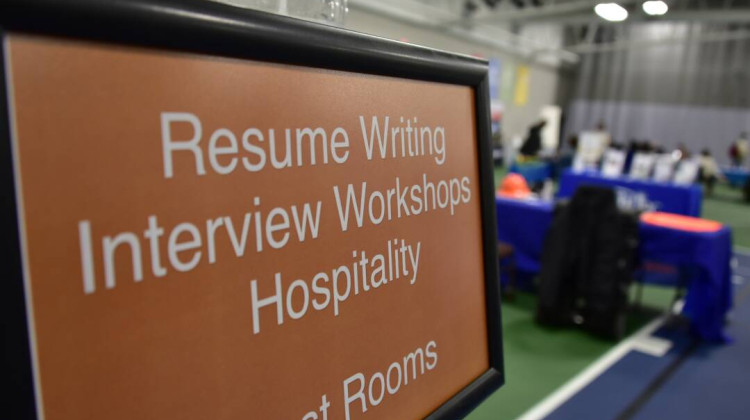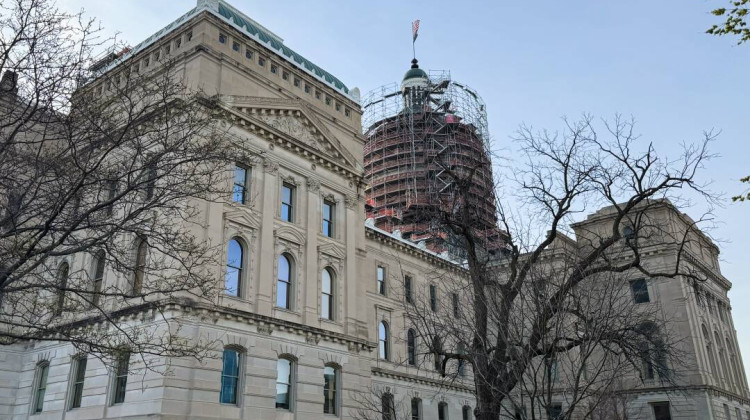
Supporters of eliminating lower truck speed limits say the state’s existing system of separate limits on certain highways increases the risk of crashes.
FILE PHOTO: Justin Hicks/IPB NewsMany highways in Indiana set speed limits of 70 miles per hour for cars and 65 for large heavy vehicles like semi-trucks. A majority of Indiana Senators passed Senate Bill 13 Monday to set a uniform speed limit of 70, despite some uncertainty over whether that’s the safest course of action.
SB 13’s author Sen. Jim Tomes (R-Wadesville) and other supporters of eliminating lower truck speed limits say the state’s existing system of separate limits on certain highways increases the risk of crashes.
Tomes, who was a truck driver for over 30 years, said trucks that are in fleets usually have mechanisms that prevent them from going over the speed limit.
“A lot of independent (truck drivers) and other trucks that [are] out there on the road, they can run much faster. And so when these guys come up on the slower moving trucks, they got to find a spot to get over in the left lane to get around them. And then they got to get their speed back up to overtake that truck,” Tomes said during committee discussion on SB 13. “Now everybody behind these trucks are backing up, waiting for this truck to get up to speed to get around the slower truck and get back over.”
Ross Akers with a Crawfordsville, IN trucking company called Akers Enterprises told lawmakers he’s in favor of this bill “not because we want our drivers to drive faster” but because “the interaction between the cars and the semis passing each other creates a safety hazard for our drivers and the rest of the drivers on the road.”
There is some opposition to the idea. Robert Haag, owner of the Indianapolis-based Perfect Transportation truck fleet and chairman of Indiana’s Motor Truck Association board, argued lawmakers are taking the wrong approach.
“We agree that the increased speed differentials are a problem. But the argument isn't the trucks are going too slow and they need to go faster. The reality is cars are going too fast,” Haag said. “Our current highway infrastructure is overburdened. Most notable is the need for six or more lane highways between major urban areas. This is taking not just years, but decades to complete. We should be focusing on the proximity of vehicles traveling on our roadways and not just the throughput of speed.”
Join the conversation and sign up for the Indiana Two-Way. Text "Indiana" to 73224. Your comments and questions in response to our weekly text help us find the answers you need on statewide issues throughout the legislative session. And follow along with our bill tracker.
Several studies, including one in 2019 by Purdue University in partnership with the Indiana Department of Transportation, do back up the idea that uniform speed limits reduce safety risks on the road.
During committee testimony, INDOT legislative director Andrea Zimmerman explained the results of the 2019 Purdue studies to lawmakers.
“We saw that [a uniform 70-mile-per-hour speed limit] would increase car speeds by 1.4 miles per hour and increase truck speeds by .6 miles per hour,” Zimmerman said. “This would reduce crash frequency by approximately 20% across all severity levels and result in a $479.3 million annual net benefit.”
However, the Purdue study’s authors also noted that other studies on this matter had “inconclusive and in some cases contradictory results.”
One from 2009, for example, “found that a higher speed limit for trucks promoted significantly higher fatality rates, but the difference in speed limit between cars and trucks had no significant effect.” Another set of studies released between 1991 and 2006 found that changing from a differential speed limit of 65 for cars and 55 for trucks to just 65 “produced no significant decrease in the [truck on other vehicle] crash rate, or in the rate of any two-vehicle collisions.”
The Purdue study used data from Indiana’s differential speed limit highways and Illinois’ uniform speed limit highways to model how the different speed limit systems affect crashes and other roadway matters.
They note that Illinois’ uniform speed limits are usually 70 miles per hour, except in areas that the state considers to be at high risk for crashes. Those areas drop to a 65-mile-per-hour speed limit. As a result, the study's authors say their model isn’t equipped to compare the safety impacts of a lower uniform speed limit, like Haag suggested, to the 70-mile-per-hour uniform limit proposed in SB 13.
The bill now heads to the House.
Adam is our labor and employment reporter. Contact him at arayes@wvpe.org or follow him on Twitter at @arayesIPB.
9(MDAyMzk1MzA4MDE2MjY3OTY1MjM5ZDJjYQ000))
 DONATE
DONATE






 Support WFYI. We can't do it without you.
Support WFYI. We can't do it without you.